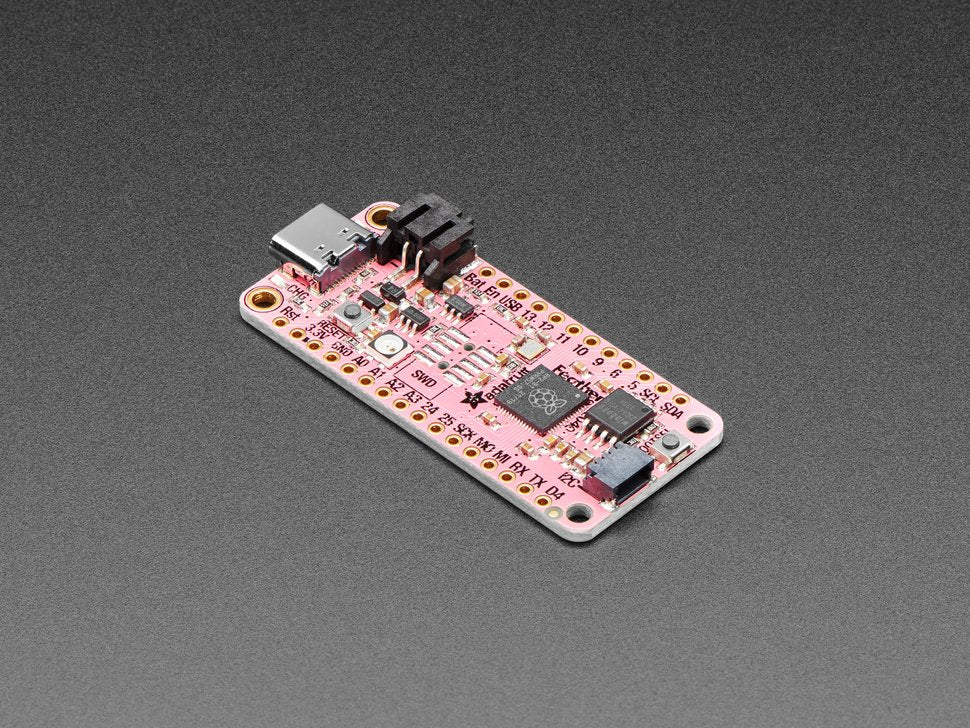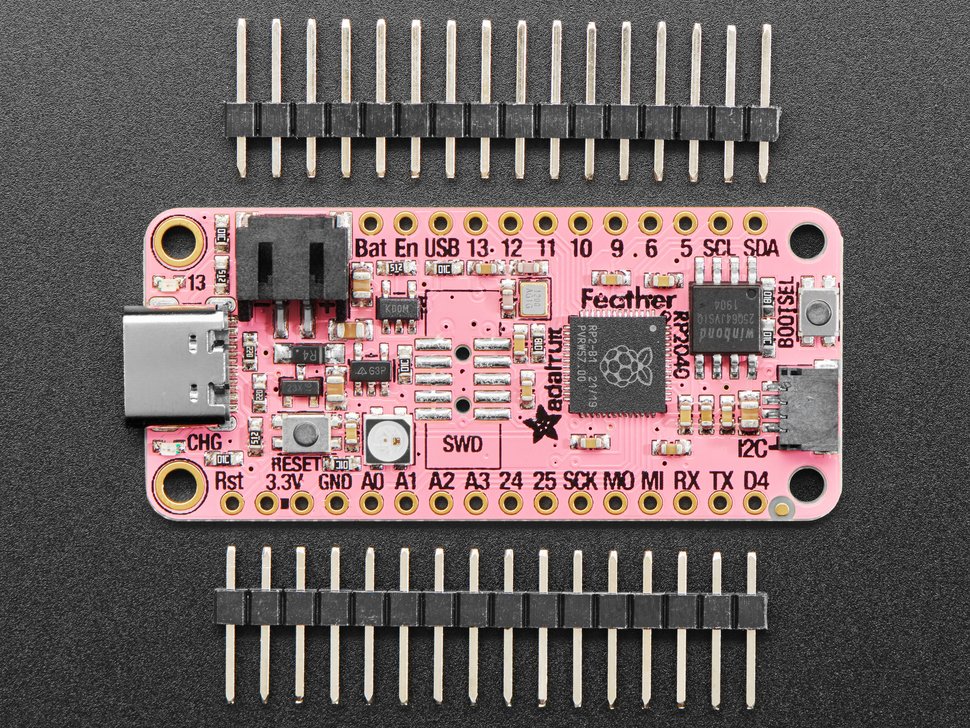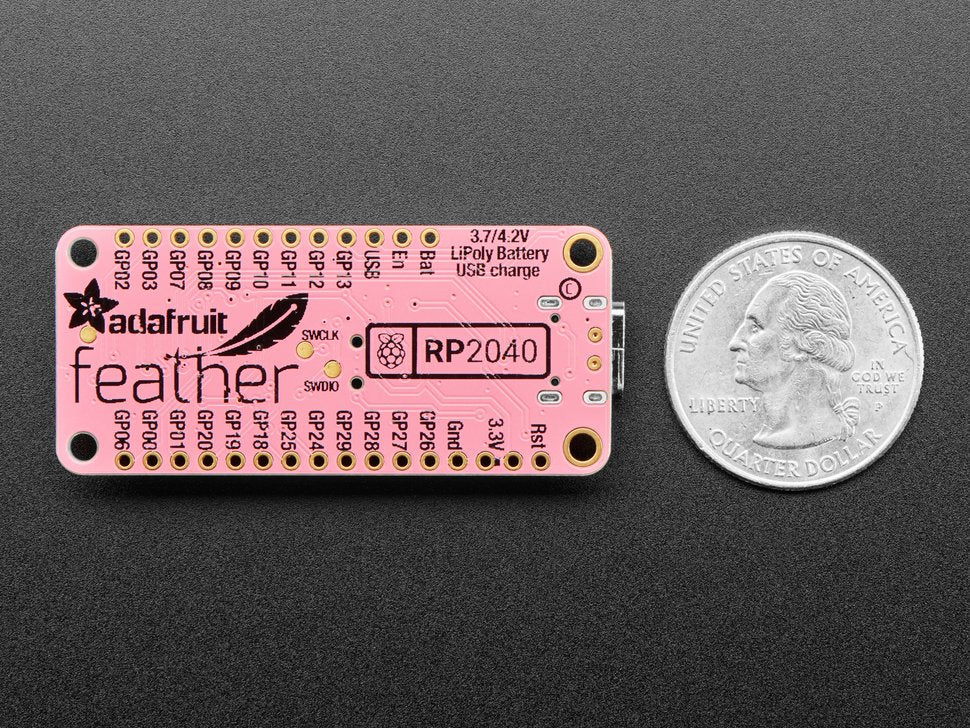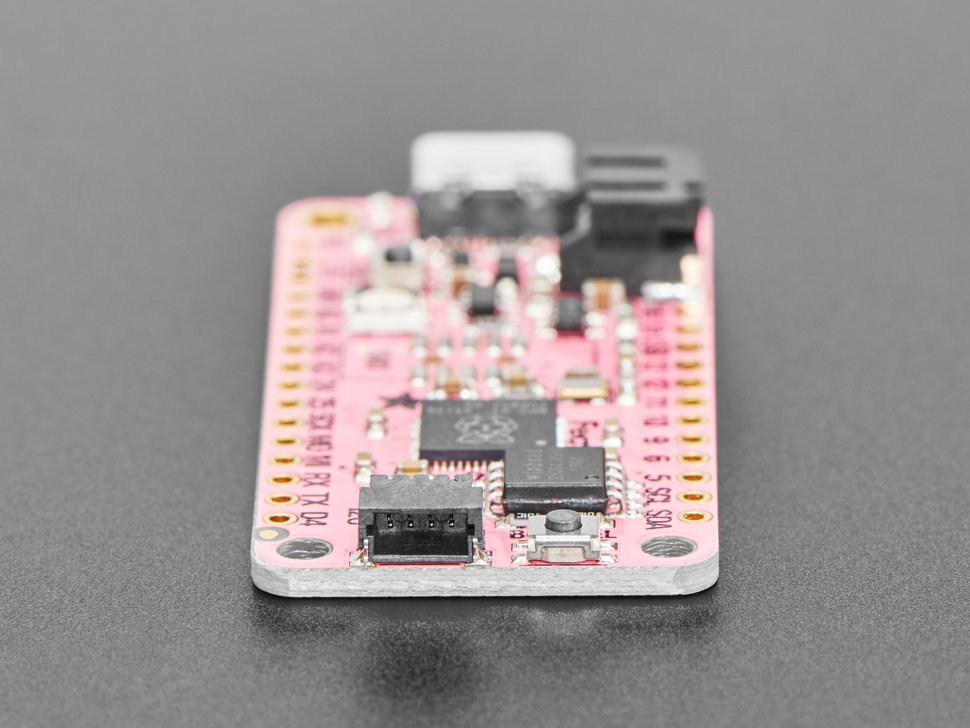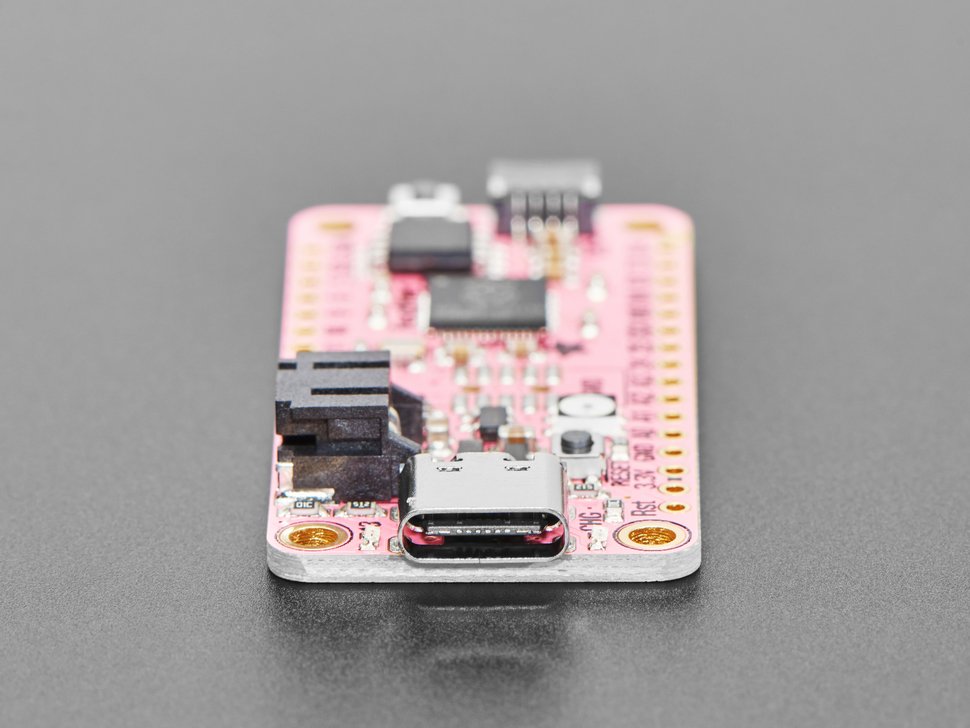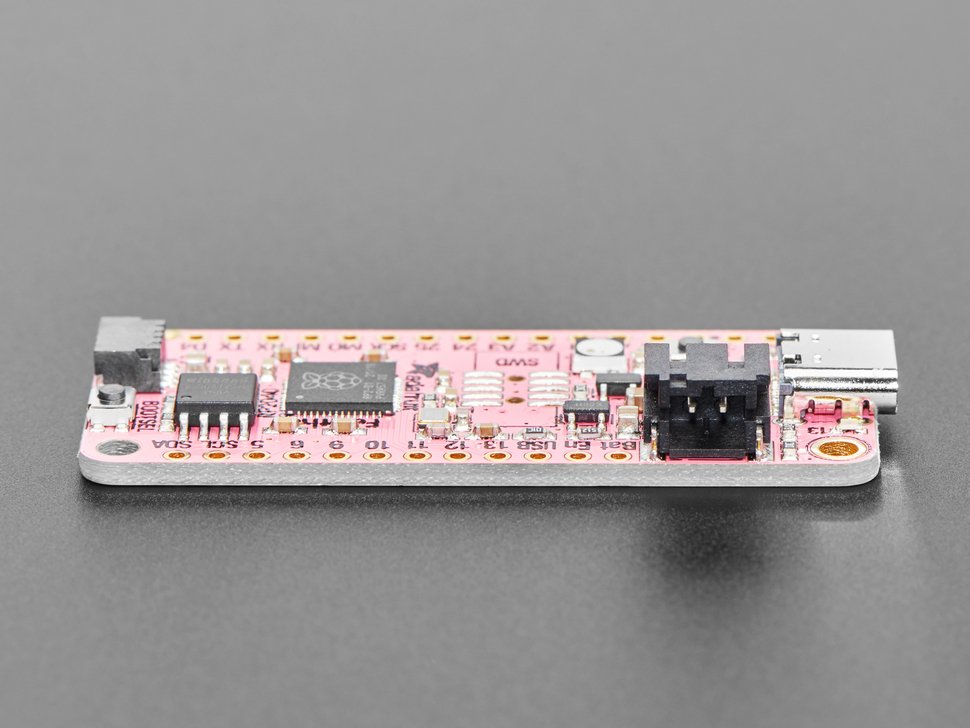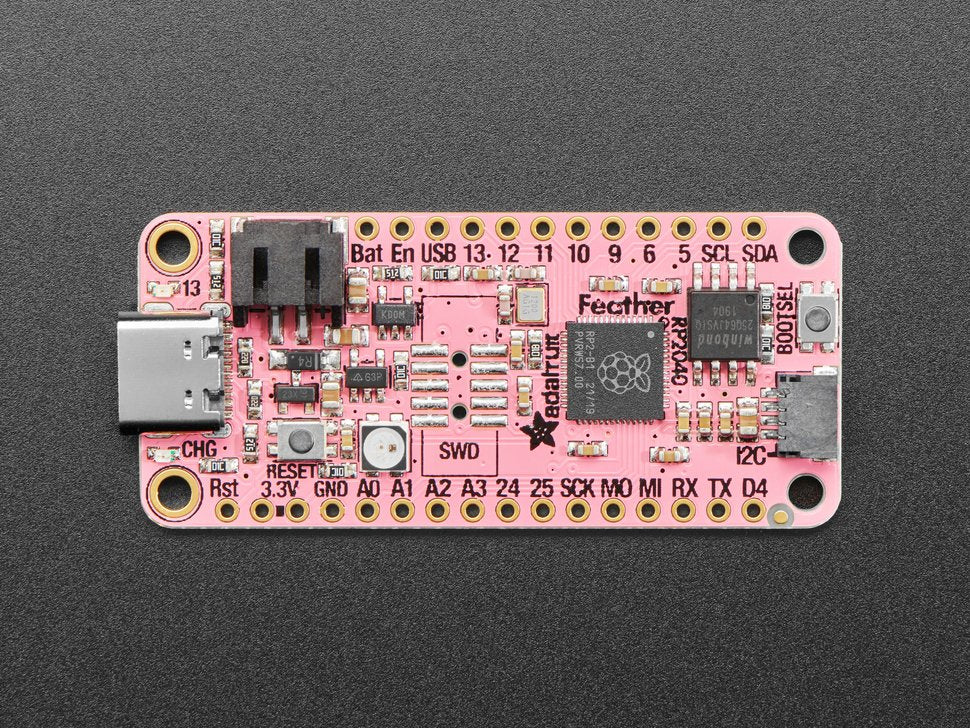Ein neuer Chip bedeutet einen neuen Feather, und der Raspberry Pi RP2040 ist da keine Ausnahme. Als Adafruit diesen Chip sahen, dachten sie: "Dieser Chip wird großartig sein, nach der Feather-Behandlung", und das hat Adafruit getan! Dieser Feather verfügt über den RP2040 und alle Annehmlichkeiten, die Sie von Feather kennen und lieben
- Maße: 2.0" x 0.9" x 0.28" (50.8mm x 22.8mm x 7mm) ohne eingelötete Header
- Leicht wie eine (große?) Feder - 5 Gramm
- Neue rosa Platine!
- RP2040 32-bit Cortex M0+ Dual-Core mit ~125 MHz bei 3,3V Logik und Leistung
- 264 KB RAM
- 8 MB SPI FLASH Chip zum Speichern von Dateien und CircuitPython/MicroPython Code. Kein EEPROM
- Tonnenweise GPIO! 21 x GPIO-Pins mit den folgenden Fähigkeiten:
- Vier 12 Bit ADCs (einer mehr als beim Pico)
- Zwei I2C-, zwei SPI- und zwei UART-Peripheriegeräte, von denen eines für die 'Haupt'-Schnittstelle in Standard-Feather-Positionen beschriftet ist
- 16 x PWM-Ausgänge - für Servos, LEDs, etc.
- Die 8 digitalen "Nicht-ADC/Nicht-Peripherie"-GPIO sind aufeinanderfolgend für maximale PIO-Kompatibilität
- Eingebautes 200mA+ Lipoly-Ladegerät mit Ladestatusanzeige-LED
- Pin #13 rote LED für allgemeine Blinkfunktion
- RGB NeoPixel für Vollfarbanzeige.
- On-Board STEMMA QT-Anschluss, über den Sie schnell und ohne Löten beliebige Qwiic-, STEMMA QT- oder Grove I2C-Geräte anschließen können!
- Reset-Taste und Bootloader-Auswahltaste für schnelle Neustarts (kein Ausstecken und Wiedereinstecken, um den Code neu zu starten)
- 3,3-V-Stromversorgungs-/Enable-Pin
- Optionaler SWD-Debug-Port kann für Debug-Zugriff eingelötet werden
- 4 Befestigungslöcher
- 12-MHz-Quarz für perfektes Timing.
- 3,3-V-Regler mit 500-mA-Spitzenstromausgang
- USB-Typ-C-Anschluss ermöglicht den Zugriff auf den integrierten ROM-USB-Bootloader und Debugging über die serielle Schnittstelle
Im RP2040 befindet sich ein 'permanenter ROM' USB UF2 Bootloader. Das heißt, wenn Sie eine neue Firmware programmieren wollen, können Sie die BOOTSEL-Taste gedrückt halten, während Sie das Gerät an den USB-Anschluss anschließen (oder den RUN/Reset-Pin auf Masse ziehen), und es erscheint als USB-Laufwerk, auf das Sie die Firmware ziehen können. Diejenigen, die Adafruit-Produkte verwendet haben, werden dies sehr vertraut finden - Adafruit verwendet diese Technik auf all ihren nativen USB-Boards. Beachten Sie nur, dass Sie nicht auf Reset doppelklicken, sondern BOOTSEL während des Bootens gedrückt halten, um den Bootloader zu starten!
Der RP2040 ist ein leistungsfähiger Chip, der die Taktrate von Adafruits M4 (SAMD51) hat und zwei Kerne, die ihrem M0 (SAMD21) entsprechen. Da es sich um einen M0-Chip handelt, verfügt er nicht über eine Fließkommaeinheit oder DSP-Hardwareunterstützung - wenn Sie also etwas mit umfangreichen Fließkommaberechnungen machen, wird dies in Software erledigt und ist daher nicht so schnell wie ein M4. Bei vielen anderen Rechenaufgaben erreichen Sie annähernd M4-Geschwindigkeiten!
Für die Peripherie gibt es zwei I2C-Controller, zwei SPI-Controller und zwei UARTs, die über GPIO gemultiplext sind - welche Pins auf welche Weise belegt werden können, ist in der Pinbelegung angegeben. Es gibt 16 PWM-Kanäle, jeder Pin hat einen Kanal, auf den er eingestellt werden kann (dito in der Pinbelegung).
Sie werden feststellen, dass es kein I2S-Peripheriegerät, kein SDIO und keine Kamera gibt, was ist damit? Nun, statt spezifischer Hardware-Unterstützung für serielle Peripheriegeräte wie diese, kommt das RP2040 mit dem PIO-State-Machine-System, das eine einzigartige und leistungsstarke Möglichkeit bietet, eigene Hardware-Logik und Datenverarbeitungsblöcke zu erstellen, die eigenständig laufen, ohne eine CPU zu beanspruchen. Zum Beispiel NeoPixels - oft wird das Timing-spezifische Protokoll für diese LEDs gebitbangt. Für den RP2040 wird stattdessen ein PIO-Objekt verwendet, das den Datenpuffer einliest und den richtigen Bitstream mit perfekter Genauigkeit ausgibt. Dasselbe gilt für I2S-Audioeingänge und -ausgänge, LED-Matrix-Displays, 8-Bit- oder SPI-basierte TFTs und sogar VGA! In MicroPython und CircuitPython können Sie PIO-Steuerbefehle erstellen, um das Peripheriegerät zu skripten und es zur Laufzeit zu laden. Es gibt 2 PIO-Peripheriegeräte mit jeweils 4 Zustandsautomaten.
Es gibt eine großartige C/C++-Unterstützung, inoffizielle (aber wirklich gute) Arduino-Unterstützung, eine offizielle MicroPython-Portierung und eine CircuitPython-Portierung! Adafruit empfiehlt natürlich CircuitPython, weil sie denken, dass es der einfachste Weg ist, um anzufangen und weil es Unterstützung für die meisten von Adafruits Treibern, Displays, Sensoren bietet, die von Anfang an unterstützt werden, so dass Sie Adafruits CircuitPython-Projekten und -Tutorials folgen können.
Der RP2040 hat zwar viel Onboard-RAM (264KB), aber keinen eingebauten FLASH-Speicher. Dieser wird stattdessen von einem externen QSPI-Flash-Chip bereitgestellt. Auf diesem Board gibt es 8 MB, die sich das laufende Programm und der von MicroPython oder CircuitPython verwendete Dateispeicher teilen. Bei der Verwendung von C/C++ steht der gesamte Flash-Speicher zur Verfügung, bei der Verwendung von Python verbleiben etwa 7 MB für Code, Dateien, Bilder, Fonts, etc.
RP2040 Chip Eigenschaften
- Zwei ARM Cortex-M0+ mit 133MHz
- 264kB On-Chip-SRAM in sechs unabhängigen Bänken
- Unterstützung für bis zu 16 MB Off-Chip-Flash-Speicher über dedizierten QSPI-Bus
- DMA-Steuerung
- Vollständig angeschlossene AHB-Crossbar
- Interpolator- und Integer-Teiler-Peripherie
- On-Chip programmierbarer LDO zur Erzeugung der Kernspannung
- 2 On-Chip-PLLs zur Erzeugung von USB- und Kerntakten
- 30 GPIO-Pins, von denen 4 als Analogeingänge verwendet werden können
- Peripheriegeräte
- 2 UARTs
- 2 SPI-Steuerungen
- 2 I2C-Steuerungen
- 16 PWM-Kanäle
- USB 1.1-Controller und PHY, mit Host- und Geräteunterstützung
- 8 PIO-Zustandsmaschinen
Wird komplett montiert und getestet geliefert, mit dem UF2 USB Bootloader. Esliegen auch einige Header bei, so dass Sie es einlöten und in ein lötfreies Breadboard einstecken können.
Technische Details
Revision Geschichte:
Stand: 23. Februar 2022 - die Platine ist jetzt rosa! Das Design ist ansonsten identisch in Schaltplan, Layout und Anwendung.
Produkt-Abmessungen: 51.0mm x 23.0mm x 7.5mm / 2.0" x 0.9" x 0.3"
English Description
A new chip means a new Feather, and the Raspberry Pi RP2040 is no exception. When Adafruit saw this chip they thought "this chip is going to be awesome when we give it the Feather Treatment" and so they did! This Feather features the RP2040, and all niceties you know and love about Feather
- Measures 2.0" x 0.9" x 0.28" (50.8mm x 22.8mm x 7mm) without headers soldered in
- Light as a (large?) feather - 5 grams
- New pink PCB!
- RP2040 32-bit Cortex M0+ dual core running at ~125 MHz @ 3.3V logic and power
- 264 KB RAM
- 8 MB SPI FLASH chip for storing files and CircuitPython/MicroPython code storage. No EEPROM
-
Tons of GPIO! 21 x GPIO pins with following capabilities:
- Four 12 bit ADCs (one more than Pico)
- Two I2C, Two SPI and two UART peripherals, one is labelled for the 'main' interface in standard Feather locations
- 16 x PWM outputs - for servos, LEDs, etc
- The 8 digital 'non-ADC/non-peripheral' GPIO are consecutive for maximum PIO compatibility
- Built in 200mA+ lipoly charger with charging status indicator LED
- Pin #13 red LED for general purpose blinking
- RGB NeoPixel for full color indication.
- On-board STEMMA QT connector that lets you quickly connect any Qwiic, STEMMA QT or Grove I2C devices with no soldering!
- Both Reset button and Bootloader select button for quick restarts (no unplugging-replugging to relaunch code)
- 3.3V Power/enable pin
- Optional SWD debug port can be soldered in for debug access
- 4 mounting holes
- 12 MHz crystal for perfect timing.
- 3.3V regulator with 500mA peak current output
- USB Type C connector lets you access built-in ROM USB bootloader and serial port debugging
Inside the RP2040 is a 'permanent ROM' USB UF2 bootloader. What that means is when you want to program new firmware, you can hold down the BOOTSEL button while plugging it into USB (or pulling down the RUN/Reset pin to ground) and it will appear as a USB disk drive you can drag the firmware onto. Folks who have been using Adafruit products will find this very familiar - Adafruit uses the technique on all our native-USB boards. Just note you don't double-click reset, instead hold down BOOTSEL during boot to enter the bootloader!
The RP2040 is a powerful chip, which has the clock speed of our M4 (SAMD51), and two cores that are equivalent to our M0 (SAMD21). Since it is an M0 chip, it does not have a floating point unit, or DSP hardware support - so if you're doing something with heavy floating-point math, it will be done in software and thus not as fast as an M4. For many other computational tasks, you'll get close-to-M4 speeds!
For peripherals, there are two I2C controllers, two SPI controllers, and two UARTs that are multiplexed across the GPIO - check the pinout for what pins can be set to which. There are 16 PWM channels, each pin has a channel it can be set to (ditto on the pinout).
You'll note there's no I2S peripheral, or SDIO, or camera, what's up with that? Well instead of having specific hardware support for serial-data-like peripherals like these, the RP2040 comes with the PIO state machine system which is a unique and powerful way to create custom hardware logic and data processing blocks that run on their own without taking up a CPU. For example, NeoPixels - often the timing-specific protocol for these LEDs get bitbanged. For the RP2040, instead a PIO object is used that reads in the data buffer and clocks out the right bitstream with perfect accuracy. Same with I2S audio in or out, LED matrix displays, 8-bit or SPI based TFTs, even VGA! In MicroPython and CircuitPython you can create PIO control commands to script the peripheral and load it in at runtime. There are 2 PIO peripherals with 4 state machines each.
There is great C/C++ support, unofficial (but really good) Arduino support, an official MicroPython port, and a CircuitPython port! Adafruit of course recommend CircuitPython because they think it's the easiest way to get started and it has support with most of our drivers, displays, sensors, and more, supported out of the box so you can follow along with our CircuitPython projects and tutorials.
While the RP2040 has lots of onboard RAM (264KB), it does not have built-in FLASH memory. Instead, that is provided by the external QSPI flash chip. On this board there is 8 MB, which is shared between the program it's running and any file storage used by MicroPython or CircuitPython. When using C/C++ you get the whole flash memory, if using Python you will have about 7 MB remaining for code, files, images, fonts, etc.
RP2040 Chip features:
- Dual ARM Cortex-M0+ @ 133MHz
- 264kB on-chip SRAM in six independent banks
- Support for up to 16MB of off-chip Flash memory via dedicated QSPI bus
- DMA controller
- Fully-connected AHB crossbar
- Interpolator and integer divider peripherals
- On-chip programmable LDO to generate core voltage
- 2 on-chip PLLs to generate USB and core clocks
- 30 GPIO pins, 4 of which can be used as analog inputs
- Peripherals
- 2 UARTs
- 2 SPI controllers
- 2 I2C controllers
- 16 PWM channels
- USB 1.1 controller and PHY, with host and device support
- 8 PIO state machines
Comes fully assembled and tested, with the UF2 USB bootloader. Adafruit also toss in some header, so you can solder it in and plug it into a solderless breadboard.
Technical Details
Revision History:
- As of Feb 23, 2022 - the PCB is now pink! The design is otherwise identical in schematic, layout and usage.
Product Dimensions: 51.0mm x 23.0mm x 7.5mm / 2.0" x 0.9" x 0.3"
Sicherheitsangaben
- Lesen Sie die Bedienungsanleitung sorgfältig durch, bevor Sie das Produkt verwenden.
- Stellen Sie sicher, dass alle Montage- und Installationsanweisungen des Herstellers sorgfältig befolgt werden.
- Verwenden Sie das Produkt nur für den vorgesehenen Zweck.
- Die unsachgemäße Nutzung dieses Produkts kann zu schweren Verletzungen oder Sachschäden führen.
- Nicht für Kinder unter 10 Jahren geeignet.
- Bei unsachgemäßer Verwendung besteht eine Verletzungsgefahr.
- Dieses Produkt entspricht den geltenden Sicherheitsanforderungen der Europäischen Union.
- Dieses Produkt wurde gemäß der GPSR geprüft, die sicherstellt, dass alle relevanten Sicherheitsanforderungen für Konsumgüter eingehalten werden.
Nachverfolgbarkeitsinformationen
Jedes Produkt verfügt über eines oder mehrere der folgenden Merkmale:
- Ein CE-Kennzeichen, das die Einhaltung der Sicherheits-, Gesundheits- und Umweltschutzanforderungen der Europäischen Union anzeigt.
- Eine eindeutige Serien- oder Chargennummer, um die Nachverfolgbarkeit zu gewährleisten und bei Bedarf Rückrufaktionen zu unterstützen.
- Hersteller- und Importeurangaben für den Kundensupport und Sicherheitsanfragen.
Überwachung und Berichterstattung von Vorfällen
Für den unwahrscheinlichen Fall eines Produktproblems haben wir Verfahren implementiert, um:
- Kundenbeschwerden zeitnah bearbeiten.
- Schwerwiegende Vorfälle über das EU Safety Gate/RAPEX-System melden.
- Mit den Marktüberwachungsbehörden zusammenarbeiten, um die öffentliche Sicherheit zu gewährleisten.
Kontakt:
- Email: support [@] pi3g.com
- Telefon: 0341 / 392 858 40
Dieses Produkt ist vollständig mit allen geltenden EU-Vorschriften konform, um die Sicherheit unserer geschätzten Kunden zu gewährleisten.

